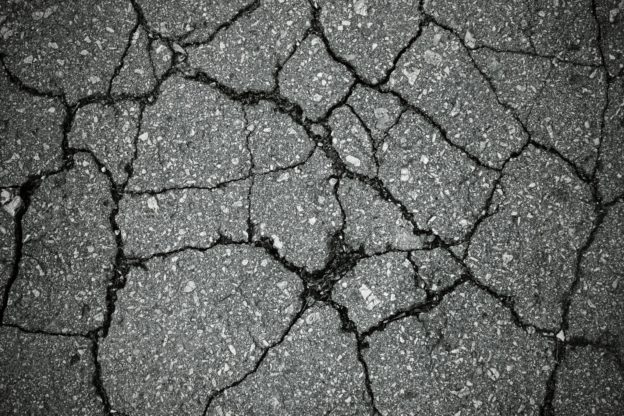Commercial asphalt undoubtedly sees a lot of use. Your residential driveway is probably asphalt, and you likely only have a few cars drive on that in a year, but driveway cracks appear almost as quickly as you can have it repaved. Commercial parking lots, loading zones, roads, and walkways are essential facets of your business. They give your visitors somewhere to park, insight into the direction they need to travel, and provide a smooth surface for vehicles to access your property and services.
Asphalt is the number one paving material for parking lots around the world — and for good reason. It’s durable and long-lasting, but that doesn’t mean it’s without issue. Asphalt pavement requires regular maintenance to keep it in good condition. Depending on the location of your asphalt pavement, you may face certain maintenance challenges. Because of its frequent use and exposure to the elements, asphalt pavement is continuously under stress.
Below you’ll find a few of the types of pavement cracking to look out for and how they appear:
Block Cracking
Block cracking occurs when old or too-dry mix was used in the installation of your pavement. If this is the case, you will start to see signs of block cracking within two to three years of installation. The good news about block cracking is that it’s primarily aesthetic, and it does not impact the structural integrity of the sub-layers. Block cracking is easily repaired with surface treatments.
Edge Cracking
As the name suggests, edge cracking occurs around the edges of your pavement. Edge cracks result from poor drainage, dry and shrinking dirt below, excessive plant growth along the pavement edge, and overuse. Generally, edge cracking occurs in long vertical cracks. Fortunately, the cracks can be repaired with asphalt crack sealant, but it’s essential to address the root cause to prevent further edge cracking. Ask your asphalt paver to remove the existing vegetation along the edge of your pavement.
Fatigue or “Alligator” Cracking
Fatigue cracking — also regarded as alligator cracking — is one of the most common forms of cracking in asphalt. It starts with a few small cracks that continue to spread across the surface of the asphalt until it bears a striking resemblance to alligator’s rough skin. Alligator occurs due to faulty installation, chronic overuse, excessive loads, frequent temperature fluctuations, or inadequate drainage.
Unlike some other forms of pavement cracking, fatigue cracking impacts every form of your asphalt, including the sublayers. For this reason, alligator cracking is best remedied with in-depth patches and restoration efforts.
Linear and Transverse Cracking
Asphalt pavement is laid in strips and sections, which means each section meets at a joint. If the joints are poorly constructed, cracks form between the sections of pavement. Although poor construction is likely the main culprit, shrinking and dry earth underneath, temperature fluctuations also impact the severity of linear and transverse cracks. These pavement cracks create pools of excess water which can damage or erode the subbase. In this case, your pavement contractor will likely recommend a combination treatment of asphalt and sand.
Reflection Cracking
Reflection cracks will often appear as a grid of straight cracks across the surface of the pavement. It mirrors cracks in the sublayer. Like many cracks, reflection cracks can be repaired with a sealant and asphalt fill.
Slippage Cracks
Slippage cracks get their name from the “slipping” appearance of the asphalt’s surface. Slippage cracks are noticeable by their deep, wide-open gaps and wrinkles. In some cases, installation goes awry, and the top layer fails to adhere to the sublayers properly. Occasionally, slippage cracks are the result of too much sand in the asphalt mix.
For more information about asphalt paving, the types of asphalt cracks, and the repairs they require, don’t hesitate to reach out to our team today!






 866-WE-TOP-EM
866-WE-TOP-EM